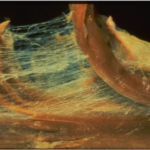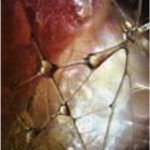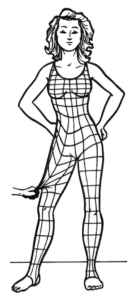Myofascia is the name given to the part of the connective tissue system (fascia) that separates and contains every muscle of the body.
Fascia binds specific cells into tissue, tissue to organs, organs into systems, cements muscles to bones, ties bones to joints, wraps every nerve, every vessel, laces all internal structures into place, and envelopes the body as a whole… every part of us is in its embrace.1
Physical Characteristics
Fascia is made up of a variety of cells suspended in an “Extracellular matrix (ECM)” or “mucopolysaccharide complex” or “ground substance”. Depending on its function in the body there will be different proportions of cells & ECM within the fascia.
Healthy ECM is composed of-
* Water (60 – 80%) * Collagen fibres (Triple helix of collagen fibrils) * Elastic fibres (Elastin/Fibrillin) * Hyaluronic Acid (Glycosaminoglycan or GAGs)
Typical cells in fascia include-
* Leukocytes (White blood cells) * Adipocytes (stores triglycerides (fat) ) * Mast cells (produce histamine) * Pericyte (regulate capillary form and function) * Fibroblasts (produces collagen & elastic fibres & ECM)
Properties of Myofascia
- Tensile Strength – collagen fibers can support 10,000x there own weight
- Elasticity – elastic fibers can stretch 150% and return without damage
- Compressive Strength – bonded water molecules resist compression
- Visoelasticity & Plasticity – time-dependent deformation resistance to shear/strain forces
- Thixotrophic – Decreasing viscosity when subjected to force over time
- Mechnotransduction sensitivity – ‘instant’ intracellular (via cytoskeleton) & intercellular (via ECM) transmission of kinetic energy & physical strain to absorb, dissipate and adapt and/or repair structure
- Excitability & Contractability – responds to mechanical strain and cytokines by transforming fibroblasts into myofibroblasts (MFB). Used to counteract chronic tension or close-off wounds. MFB normally degrade when wound healed or enough collagen has been laid down to counteract strain.
- Structural Biotensegrity – biomechanical concept of how fascia contributes to structure of the human body. All bones of the skeleton are suspended within fascial layers, not the other way round (as traditionally thought). Stress & strain absorbed in one place is readily distributed throughout the entire structure.
We have invented material that is stronger OR more elastic OR more resistant to damage but there is nothing that is as versatile as healthy living fascia. Fascia cannot respond immediately to the electro-chemical signals of the efferent nervous system like muscle fibers (maybe why its ignored by some PTs/physios) – but it is extremely responsive to kinetic energy (pressure/tension/shear forces) and I try to use this response in Myofascial Release therapy.
The majority of afferent nerve endings are contained within fascia (in its broadest term). These include proprioceptors (spacial awareness), mechanoreceptors (movement rate/distance) and nociceptors (pain).
Function of Myofascia
Myofascia is scaffolding for muscles, keeping them separate or together when needed for movement (conscious or unconscious). It is believed it is constantly adapting to the environment by using mechanotranduction and the biotensegrity model.
Myofascia in a human body has intrinsic tone and is never completely lax (stress/strain relationship in-vivo can never reach zero). The mechanics of a tensegrity structure differ from the ‘lever mechanics’ that have been applied to biological structures since Borelli’s Treatise (1680).
Contrary to lever mechanics, biotensegrity systems only have tension (myofascia) and compressive (bones) structures. There is no shear, torque or bending moments. Orientation in space has no effect on how the body moves. Forces are distributed throughout the system rather than locally concentrated as they are in pure lever systems.

Movement is not just bending of hinges, but expansion, contraction and instant repositioning of tensegrities (body ‘parts’). The musculoskeletal system therefore functions as a single unit and is much more energy efficient and freely moving as a result.
Myofascia is (for better or worse!) continually tensed by intrinsic tension and active contractions. Misuse, disuse or overuse injuries that can cause pain and/or imbalance can be ‘tuned’ to find better ‘balance’ with myofascial release and function training.
To book a Myofascia Release consultation and treatment in Marlow with Mark please check availability and book online here.
References
Findley, T. (2009) Second International Fascia Research Congress. International Journal of Therapeutic Massage & Bodywork: Research, Education, & Practice. 2(2) pp. 1-6.
Ingber, D. (2006) Cellular mechnotransduction: putting all the pieces together again. The Federation of American Societies for Experimental Biology. 20 pp. 811-827.
1 Juhan, D. (2003) 3rd ed. Job’s Body. Station Hill Press, Barry Town, USA.
Myers, T. (2009) 2nd ed. Anatomy trains. Edinburgh: Churchill Livingstone Elsevier. & www.anatomytrains.com
Levin, S. & Martin, D. (2012) Biotensegrity. in Schleip, R., Findley, T., Chaitow, L. & Huijing, P. (eds.) Fascia, the tensional network of the human body. Edinburgh: Churchill Livingstone Elsevier.




 Enter your name and email and request our free ebook: 7 Habits of Highly Effective Runners
Enter your name and email and request our free ebook: 7 Habits of Highly Effective Runners